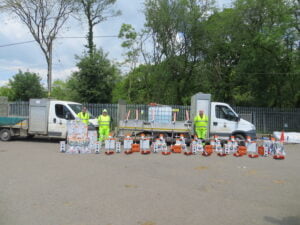The WHO’s interim target for air quality could be achieved across most of the UK by 2030, if current and proposed policies are fully implemented.
A new report has found that implementing existing UK government plans by 2030, combined with the Climate Change Committee’s vehicle forecasts and focused London policies, would have significant positive impacts on public health and help achieve Net Zero.
The report, carried out by researchers from Imperial College London’s Environmental Research Group, was commissioned by the Clean Air Fund via Imperial Projects.
Meeting the World Health Organisation’s (WHO) interim target for fine particulate matter (PM2.5) of 10 micrograms per cubic metre (WHO-10) could lead to children across the UK suffering an average of 388,000 fewer days of asthma symptoms a year. The UK would also see a fall in cases of coronary heart disease of over 3,000 cases on average per year, and a rise in average life expectancy of 9-10 weeks across those born in 2018.
In total, the health and economic benefits, including reduced pressure on the NHS and higher productivity, could be worth up to £380bn between 2018 and 2134.
An important aim of this project was to assess whether WHO-10 could be met in the UK, and the team hope that this will provide useful evidence towards the UK Government’s target setting consultation.
Professor Frank Kelly, Battcock Chair in Community Health and Policy, Environmental Research Group, said: “People living in the UK have long suffered from the health effects of poor air quality. As this report demonstrates, there is no excuse for such a situation to continue. We understand the sources of air pollution that must be targeted, and we have the technologies to reduce emissions to low levels or to eliminate them completely. By grasping this knowledge and capability now, the UK Government can improve our air quality and the health of people of all ages and at the same time, contribute to climate neutrality.”
Man made particles come from the combustion of solid and liquid fuels, through sources such as power generation, industry, domestic heating, cooking and from both vehicle exhausts and from brake wear, tyre wear and resuspension from the road.
PM2.5 is the most damaging type of air pollution: breathing it in for just a few hours or days is harmful, and exposure over months or years is particularly dangerous. It is associated with multiple causes of death – including coronary heart disease, lung cancer, chronic obstructive pulmonary disease and pneumonia – as well as both cardiovascular and respiratory diseases including asthma. Children, pregnant women, the elderly, and people with heart and lung diseases are particularly vulnerable.
The WHO guideline limit for fine particulate matter – known as PM2.5 – was updated in 2021 in light of accumulated scientific evidence on the dangers of even low levels of air pollution. The guideline limit was reduced from an annual average of 10 micrograms per cubic metre (WHO-10) to 5 micrograms per cubic metre, with WHO-10 now an ‘interim target’.
The current UK target is 20 micrograms per cubic metre – four times higher than the new WHO recommendation – and is due to be updated later this year.
Researchers showed that the WHO-10 interim target is achievable almost everywhere in the UK by 2030, with less than 1% of the country predicted to experience pollution above the WHO interim target. Even in historically highly polluted areas like London, drastic improvements in air quality are projected (the area of London exceeding WHO-10 is predicted to drop to 0.6% by 2030 from 83% in 2018), with some additional actions required to bring these places in line with WHO-10.
Jane Burston, Executive Director at the Clean Air Fund, said: “This is a win, win, win scenario. This new research shows us that achieving much healthier air is possible across the vast majority of the UK by 2030 based on policies the government already plans to implement or that have been recommended by the Committee on Climate Change. The new air quality target for the UK should therefore align with WHO-10 at a minimum, with a view to further reducing pollution beyond this in the future. It is necessary, beneficial and achievable, and will save lives and money.”
Download the full report: Pathway to WHO: Achieving clean air in the UK





















